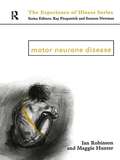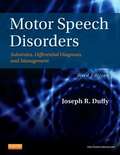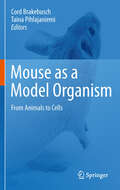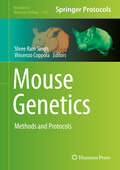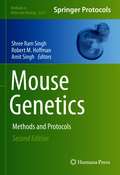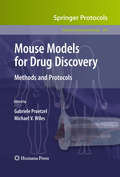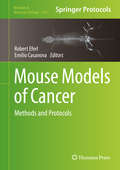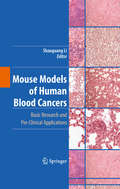- Table View
- List View
Motor Neurone Disease (Experience Of Illness Ser.)
by Margaret Hunter Ian RobinsonMotor Neurone Disease is one of the most difficult conditions to manage medically and socially. A disease which leads to the loss of control of most muscle systems of the body, it has no known cause and no cure. For this reason, clinicians have traditionally been reluctant to reveal the diagnosis to sufferers or their families and the condition has become known as one of the best kept secrets of medical practice. However in recent years a number of organizations have set up to support sufferers and their families and consequently, the public profile of the condition has changed dramatically.Motor Neurone Disease provides an extremely helpful guide to the medical facts relating to the condition and considers the psycho-social effects on sufferers and those who care for them. It will be essential reading for doctors, nurses, social workers, physio-, speech and occupational therapists as well as all those suffering from Motor Neurone Disease, their families and carers.
Motor Neurone Disease
by Margaret Hunter Ian RobinsonMotor Neurone Disease is one of the most difficult conditions to manage medically and socially. A disease which leads to the loss of control of most muscle systems of the body, it has no known cause and no cure. For this reason, clinicians have traditionally been reluctant to reveal the diagnosis to sufferers or their families and the condition has become known as one of the best kept secrets of medical practice. However in recent years a number of organizations have set up to support sufferers and their families and consequently, the public profile of the condition has changed dramatically.Motor Neurone Disease provides an extremely helpful guide to the medical facts relating to the condition and considers the psycho-social effects on sufferers and those who care for them. It will be essential reading for doctors, nurses, social workers, physio-, speech and occupational therapists as well as all those suffering from Motor Neurone Disease, their families and carers.
Motor Proteins and Molecular Motors
by Anatoly B. KolomeiskyA Unified Microscopic Approach to Analyzing Complex Processes in Molecular MotorsMotor Proteins and Molecular Motors explores the mechanisms of cellular functioning associated with several specific enzymatic molecules called motor proteins. Motor proteins, also known as molecular motors, play important roles in living systems by supporting cellular
Motor Skills Training in Orthopedic Sports Medicine
by Mustafa Karahan João Espregueira-Mendes H. Kaya AkanThis book aims to provide orthopedic surgeons with all the information that they will require in order to set up and run a motor skills course that will meet the needs of junior staff in Orthopedic Sports Medicine and help in training better surgeons for the future. The coverage is wide-ranging, from the fundamentals of what it takes to be a sports surgeon through to validation methods that measure teaching effectiveness and the certification of surgical skills at the end of the course. Clear guidance is provided on how to teach concepts of surgical skill and the strategy and practical details of designing a training program, with inclusion of a helpful checklist of do’s and don’ts. Different basic training modalities are described, with a particular focus on the FAST system adopted by the Arthroscopy Association of North America, and the role of simulators in surgical skills training is discussed. The book has been produced in cooperation with ISAKOS and the authors are leading professionals from around the world who offer a truly global and multidisciplinary perspective on the subject.
Motor Speech Disorders: Substrates, Differential Diagnosis, and Management (PDF)
by Joseph R. DuffyWith expanded and updated information including current techniques, approaches, and case studies, the 3rd edition of this bestselling book continues its reputation as a dependable and outstanding evidence-based source on acquired motor speech disorders in adults. It covers the substrates of motor speech and its disorders, the disorders and their diagnoses, and management -- focusing on integrating what is known about the bases of motor speech disorders with the realities of clinical practice to ensure readers have the key content they need to be effective practitioners. Three-part organization first covers the neurologic underpinnings of speech, then the various disorders resulting from problems in the nervous system, and then the basic principles and disorder-specific management strategies. Emphasis on evidence-based practice helps distill disparate information and stresses the best practices within motor speech disorders. Cutting-edge research ensures this book contains the most comprehensive and up-to-date look at the state of motor speech disorders. Case studies help clarify dense and difficult content and help hone your critical thinking skills. Summary tables and boxes offer easy access to important information such as causes and characteristics to aid in differential diagnosis. Chapter outline and summary sections keep you focused on the most significant information. NEW! Accompanying Evolve site features an interactive PowerPoint presentation with more than 60 audio and video clips demonstrating various disorders. NEW! Updated content incorporates Dr. Duffy's findings from nearly 1,000 new articles on motor speech disorders. UNIQUE! Two-color design and larger trim size help highlight key information and allow for easier lay-flat reading. 9780323242646
Motor Speech Disorders - E-Book: Motor Speech Disorders - E-Book
by Joseph R. DuffyWith expanded and updated information including current techniques, approaches, and case studies, the 3rd edition of this bestselling book continues its reputation as a dependable and outstanding evidence-based source on acquired motor speech disorders in adults. It covers the substrates of motor speech and its disorders, the disorders and their diagnoses, and management -- focusing on integrating what is known about the bases of motor speech disorders with the realities of clinical practice to ensure readers have the key content they need to be effective practitioners. - Three-part organization first covers the neurologic underpinnings of speech, then the various disorders resulting from problems in the nervous system, and then the basic principles and disorder-specific management strategies. - Emphasis on evidence-based practice helps distill disparate information and stresses the best practices within motor speech disorders. - Cutting-edge research ensures this book contains the most comprehensive and up-to-date look at the state of motor speech disorders. - Case studies help clarify dense and difficult content and help hone your critical thinking skills. - Summary tables and boxes offer easy access to important information such as causes and characteristics to aid in differential diagnosis. - Chapter outline and summary sections keep you focused on the most significant information. - NEW! Updated content incorporates Dr. Duffy's findings from nearly 1,000 new articles on motor speech disorders. - UNIQUE! Two-color design and larger trim size help highlight key information and allow for easier lay-flat reading.
Motor Speech Disorders E-Book: Motor Speech Disorders E-Book
by Joseph R. Duffy**Selected for Doody's Core Titles® 2024 with "Essential Purchase" designation in Communication Sciences & Disorders** Ensure you're up to speed with the most recent findings in motor speech disorders. One of the most trusted sources on this topic, Motor Speech Disorders integrates the latest neurological research with the realities of clinical practice. The fourth edition is divided into three sections which focus on substrates of motor speech and its disorders, the disorders and their diagnoses, and finally managing various treatment types. Additionally, new research on the neurologic organization of motor control, causes of motor speech disorders, and advances in the medical and behavioral management of specific disorders is incorporated throughout. Supported by a robust evolve site, this outstanding, evidence-based resource provides everything you need to become a skilled clinical practitioner. - UPDATED! Over 400 literature references emphasize clinically important information for each major part of the textbook. - UPDATED Illustrations throughout text enhance your understanding of key concepts. - UPDATED Case studies in Disorders chapters help clarify dense and difficult content and help hone your critical thinking skills. - Cutting-edge research with an emphasis on evidence-based practice ensures that this book contains the most comprehensive and up-to-date look at the state of motor speech disorders. - Logical three-part organization first covers the neurologic underpinnings of speech, then the various disorders resulting from problems in the nervous system, and then the basic principles and disorder-specific management strategies. - Summary tables and boxes offer easy access to important information such as causes and characteristics to aid in differential diagnosis. - Chapter outline and summary sections highlight key points to help you to focus on the most significant information. - NEW! 24 new audio and video clips demonstrating various disorders have been added to the accompanying Evolve website, totaling over 150 audio and video clips in the interactive PowerPoint presentations. - NEW! Clinical insights and key information summaries call out need-to-know information throughout text.
Motorische Entwicklung und Steuerung: Eine Einführung für Physiotherapeuten, Ergotherapeuten und Trainer
by Paul GeraedtsDie Faszination der menschlichen Motorik wird in diesem Fachbuch verständlich und anschaulich dargestellt. Zahlreiche Praxisbeispiele verdeutlichen Physio- und Ergotherapeuten, Sportwissenschaftlern und Trainern entscheidende Eckpfeiler der einzelnen Entwicklungsschritte von der Kindheit bis ins Erwachsenenalter. Die direkten Auswirkungen unbewusster Steuerungs-, Automatisierungs- und Lernprozesse auf unser Leben werden präzise beleuchtet und entschlüsselt.Der Inhalt: Neurophysiologische Abläufe von automatisierten und Willkürbewegungen - Aus unserem Alltag: Okulo-, Grapho- und Sprachmotorik - Verborgene Potenziale in Training und TherapieVerhelfen Sie Ihrem Patienten in Rehabilitation und Therapie zum bestmöglichen Ergebnis. Nur mit diesen Grundlagen können Sie Athleten im Breiten- und Leistungssport optimal fördern und zum gewünschten Erfolg führen.
The Moulster and Griffiths Learning Disability Nursing Model: A Framework for Practice
by Elizabeth Bailey Dave Atkinson Daniel Turner Marina Russ Lauretta Edmondson Chris Edmondson Sally Edmondson Ball Trish Griffin Lynne Westwood Elaine Thomas Norah Arnott Fiona Gibney Johnann WilsonThis book describes the Moulster and Griffiths nursing model and demonstrates how learning disability nurses can use it in practice. It provides an effective framework to assess, plan, reflect on and evaluate person-centred care, considering the complex needs of people who have learning disabilities, their families and their carers.
Mount Sinai Expert Guides: Critical Care (Mount Sinai Expert Guides)
by Stephan A. Mayer Janet M. Shapiro Umesh K. Gidwani John M. OropelloPart of the Mount Sinai Expert Guide series, this outstanding book provides rapid-access, clinical information on all aspects of Critical Care with a focus on clinical diagnosis and effective patient management. With strong focus on the very best in multidisciplinary patient care, it is the ideal point of care consultation tool for the busy physician.
Mount Sinai Expert Guides: Critical Care (Mount Sinai Expert Guides)
by Stephan A. Mayer Janet M. Shapiro Umesh Gidwani John OropelloPart of the Mount Sinai Expert Guide series, this outstanding book provides rapid-access, clinical information on all aspects of Critical Care with a focus on clinical diagnosis and effective patient management. With strong focus on the very best in multidisciplinary patient care, it is the ideal point of care consultation tool for the busy physician.
Mourning Sarah
by Theresa Huttlinger Vigour‘In this astonishing read, we follow Vigour's journey into darkness and loss, a gripping pilgrimage that leads to eventual knowledge and empowerment. This lucid book should be required reading for any woman headed to the maternity ward. This unforgettable book reveals what would have happened to my son and family had he not been treated for group B strep at birth. Let's celebrate Vigour's brave testimony here and take heed of her hard-won insights on the medical establishment that surrounds the birth experience.’ Paul Morris, Director, Master of Liberal Studies Program, Arizona State University, USA ‘A tragic story, clearly told. Theresa shares the confusion, pain and devastation she and her family experienced around the time of her daughter, Sarah's, birth and early death from potentially preventable group B Strep infection. Many who have suffered similar losses will draw comfort from this book, knowing that they aren't alone. Thankfully, as Theresa outlines, measures are now in place in the US that ensure most group B strep infections in babies are prevented there – in the UK, we're yet to achieve this, though we continue to campaign for such measures to be introduced. Perhaps were the decision makers to read this book, it would happen sooner - I fervently hope so.’ Jane Plumb, Chairman, Group B Strep Support, UK ‘Mourning Sarah is filled with important, even urgent, messages for any woman having a baby right here, right now, and for all young girls who soon will grow into womanhood and want babies of their own. Theresa Vigour articulates the unspeakable loss of her daughter using every hue in the emotional rainbow. Her account is exquisite, her metaphors masterful, and throughout the book, she skilfully weaves her inner and outer worlds. Theresa Vigour has given us a gift.’ Lorraine Ash in her Foreword 'Deep was the grief that came with the death of Theresa Vigour's newborn daughter, Sarah. Yet profound is this memoir of her mother's journey. It is a gift to see such raw and visceral emotion transformed into beautiful and evocative prose that touch and teach and heal.' Walt Harrington, author of The Everlasting Stream
Mourning Sarah
by Theresa Huttlinger Vigour‘In this astonishing read, we follow Vigour's journey into darkness and loss, a gripping pilgrimage that leads to eventual knowledge and empowerment. This lucid book should be required reading for any woman headed to the maternity ward. This unforgettable book reveals what would have happened to my son and family had he not been treated for group B strep at birth. Let's celebrate Vigour's brave testimony here and take heed of her hard-won insights on the medical establishment that surrounds the birth experience.’ Paul Morris, Director, Master of Liberal Studies Program, Arizona State University, USA ‘A tragic story, clearly told. Theresa shares the confusion, pain and devastation she and her family experienced around the time of her daughter, Sarah's, birth and early death from potentially preventable group B Strep infection. Many who have suffered similar losses will draw comfort from this book, knowing that they aren't alone. Thankfully, as Theresa outlines, measures are now in place in the US that ensure most group B strep infections in babies are prevented there – in the UK, we're yet to achieve this, though we continue to campaign for such measures to be introduced. Perhaps were the decision makers to read this book, it would happen sooner - I fervently hope so.’ Jane Plumb, Chairman, Group B Strep Support, UK ‘Mourning Sarah is filled with important, even urgent, messages for any woman having a baby right here, right now, and for all young girls who soon will grow into womanhood and want babies of their own. Theresa Vigour articulates the unspeakable loss of her daughter using every hue in the emotional rainbow. Her account is exquisite, her metaphors masterful, and throughout the book, she skilfully weaves her inner and outer worlds. Theresa Vigour has given us a gift.’ Lorraine Ash in her Foreword 'Deep was the grief that came with the death of Theresa Vigour's newborn daughter, Sarah. Yet profound is this memoir of her mother's journey. It is a gift to see such raw and visceral emotion transformed into beautiful and evocative prose that touch and teach and heal.' Walt Harrington, author of The Everlasting Stream
Mouse as a Model Organism: From Animals to Cells
by Cord Brakebusch and Taina PihlajaniemiCell culture based research is important for our understanding of biological processes at the cellular and molecular level. Using this approach, the previous decades have produced a wealth of mechanistic information in all areas of biomedical research. Such in vitro research, however, lacks the complexity of in vivo investigations, where many different cell types interact with each other in a normal, three-dimensional environment, with normal levels of cytokines and growth factors. Furthermore, complex human diseases, such as cancer, diabetes or chronic inflammation, can only be modeled in vivo. Due to its small size, its short reproduction time, and the possibility to introduce specific gene mutations, the mouse has become the favourite mammalian model organism to study in vivo function of genes during development and in disease. This book combines review articles on selected subjects presented at the symposium “Mouse as a Model Organism – From Animals to Cells”, held in Rovaniemi, Finland, 2009. Among other topics, high-throughput phenotyping of mouse mutants, mouse phenotypes dependent on nature and nuture, and a spectrum of in vivo, ex vivo and in vitro methods to study cancer in mice are described. This book will give an excellent introduction to scientists interested in the use of mice as a model to understand complex biological questions in the post-genomic era. It will highlight the possibilities, but also discuss the current problems and shortcomings, to give a realistic view of the current state-of-art in this fascinating field of biomedical research.
Mouse Development: From Oocyte to Stem Cells (Results and Problems in Cell Differentiation #55)
by Jacek Z. KubiakThe mouse is a perfect model organism to study mammalian, and thus indirectly also human, embryology. Most scientific achievements that have had an important impact on the understanding of basic mechanisms governing embryo development in humans, originated from mouse embryology. Stem cell research, which now offers the promise of regenerative medicine, began with the isolation and culture of mouse embryonic stem cells by Martin Evans (who received the Nobel Prize in medicine in 2007 for this achievement) and Matthew Kaufman. This book provides an overview of mouse development, spanning from oocytes before fertilization to the state-of-the-art description of embryonic and adult stem cells. The chapters, written by the leading specialists in the field, deal with the most recent discoveries in this extremely fast-developing area of research.
Mouse Genetics: Methods and Protocols (Methods in Molecular Biology #1194)
by Shree Ram Singh and Vincenzo CoppolaMouse Genetics: Methods and Protocols provide selected mouse genetic techniques and their application in modeling varieties of human diseases. The chapters are mainly focused on the generation of different transgenic mice to accomplish the manipulation of genes of interest, tracing cell lineages and modeling human diseases. Composed in the highly successful Methods in Molecular Biology series format, each chapter contains a brief introduction, a list of necessary materials, systematic, readily reproducible methods and a notes section, which shares tips on troubleshooting in order to avoid known pitfalls.Comprehensive and authoritative, Mouse Genetics: Methods and Protocols promises to deliver fundamental techniques and protocols to geneticists, molecular biologists, cell and developmental biologists, students and postdoctoral fellows working in the various disciplines of mouse biology and modeling human disease.
Mouse Genetics: Methods and Protocols (Methods in Molecular Biology #2224)
by Shree Ram Singh Robert M. Hoffman Amit SinghThis fully updated edition provides selected mouse genetic techniques and their application in modeling varieties of human diseases. The chapters are mainly focused on the generation of different transgenic mice to accomplish the manipulation of genes of interest, tracing cell lineages, and modeling human diseases. Written for the highly successful Methods in Molecular Biology series, chapters include introductions to their respective topics, lists of the necessary materials and reagents, step-by-step, readily reproducible laboratory protocols, and tips on troubleshooting and avoiding known pitfalls. Authoritative and up-to-date, Mouse Genetics: Methods and Protocols, Second Edition delivers fundamental techniques and protocols to geneticists, molecular biologists, cell and developmental biologists, students, and postdoctoral fellows working in the various disciplines of genetics, developmental biology, mouse genetics, and modeling human diseases.
Mouse Liver Tumors: Relevance to Human Cancer Risk Symposium of the European Society ofToxicology Held in Rome, February 2–5, 1986 (Archives of Toxicology #10)
Peroxisome proliferation in the liver parenchymal cells is frequently observed in rats and mice exposed to certain xenobiotic compounds. Hepatic peroxisome pro liferation was first noted nearly twenty years ago in the livers of rats treated with the hypolipidemic drug clofibrate (Hess et aI. , 1965; Svoboda and Azarnoff, 1966). Subsequently, several structurally unrelated hypolipidemic compounds were found to induce marked hepatomegaly and hepatic peroxisome proliferation in rats and mice, which led to the suggestion of a possible relationship between peroxisome proliferation and lipid metabolism (Reddy and Krishnakantha, 1975) as well as to the identification of a peroxisomal fatty acid f3-oxidation enzyme sys tem in the rat liver (Lazarow and DeDuve 1976). A second major class of per ox i some proliferators was identified nearly ten years ago, with the discovery that the dietary administration of a widely used phthalate-ester plasticizer di(2-ethylhex yl)phthalate (DEHP) to rats, results in the induction of peroxisomal enzymes in liver (Reddy et aL 1976a). Hypolipidemic drugs and phthalate-ester plasticizers constitute two major and important categories of chemicals with profound peroxisome proliferative property (Reddy et aL 1982; Reddy and Lalwani 1983). These two classes of xenobiotics now have important roles. First, the hypolipi demic drugs are increasingly used in the control of hyperlipidemia, a major risk factor for developing coronary heart disease.
Mouse Models for Drug Discovery: Methods and Protocols (Methods in Molecular Biology #1438)
by Gabriele Proetzel and Michael V. WilesWith genetic engineering, systems explored in this book now exist allowing for the simple, efficient, and near universally precise genetic manipulation directly in any organism, including the mouse. Herein, these models are applied to a wide field of disease areas, including diabetes, cardiovascular disease, skin disorders, cancer, neurodegenerative and neuromuscular diseases, retinal disorders, as well as various behavioral models. Written for the highly successful Methods in Molecular Biology series, chapters include introductions to their respective topics, lists of the necessary materials and reagents, step-by-step, readily reproducible laboratory protocols, and tips on troubleshooting and avoiding known pitfalls. Practical and fully updated, Mouse Models for Drug Discovery: Methods and Protocols, Second Edition serves to equip the reader with an extensive overview of techniques to utilize the many possibilities of mice in the drug development process.
Mouse Models for Drug Discovery: Methods and Protocols (Methods in Molecular Biology #602)
by Gabriele Proetzel and Michael V. WilesAs the drug discovery process shifts more and more toward specifically targeting pathways and molecules, model systems continue to increase in importance, and the mouse, with its versatility, ease of use, and remarkable similarity to the human genome, has clearly risen to the forefront of animal model studies. In Mouse Models for Drug Discovery: Methods and Protocols, experts in the field present some background for those less familiar with mice as experimental model platforms as well as a collection of techniques involving general methods as well as specific disease topics such as type 1 and 2 diabetes, cardiovascular disease, arthritis, skin disorders, cancer, the use of behavioral models for depression and anxiety, neurodegenerative diseases, neuromuscular diseases, and infectious diseases. Written in the highly successful Methods in Molecular Biology™ series format, chapters include introductions to their respective topics, lists of the necessary materials and reagents, step-by-step, readily reproducible laboratory protocols, and notes on troubleshooting and avoiding known pitfalls. Authoritative and easy-to-use, Mouse Models for Drug Discovery: Methods and Protocols will stimulate those not familiar with the power of the mouse and its potential for the drug discovery process, and it will encourage the development of new models and new ways to utilize existing models in order to further the use of this dynamic animal in this vital field.
Mouse Models in the Study of Genetic Neurological Disorders (Advances in Neurochemistry #9)
by Brian PopkoThe number of mouse models that are available for the study of human genetic neurological disorders is large and growing rapidly. Therefore, it was difficult to select the models that were reviewed in this volume. Clearly, there are important models that are not discussed, and perhaps a volume twice this size would have been more appropriate. Moreover, the pace at which new models are being developed and analyzed is rapid. As this volume goes to press, I am sure that additional mouse genes responsible for naturally occurring neurological disorders are being discovered and that many new transgenic and mutant mouse strains are being developed. Therefore, this volume should not be viewed as a comprehensive compendium, but rather as an update of work in progress. It is exhilarating to witness the fast pace at which these models are being established as important tools in the study of basic neuroscience and neurological disorders. It will be even more exciting to see their utilization in the development and testing of therapeutic interventions for these diseases. I would like to thank each of the authors who have contributed to this volume for their time and their expertise. I would also like to thank Drs. Timothy Coetzee and Joshua Corbin for their advice in the selection of the topics covered. I am deeply indebted to Dr. Kunihiko Suzuki, who first approached me with the idea for this volume, for his guidance throughout its preparation.
Mouse Models of Allergic Disease: Methods and Protocols (Methods in Molecular Biology #1032)
by Irving C. AllenOver the last half century, a dramatic increase in allergic diseases has been observed throughout industrialized nations, which has resulted in significant worldwide socio-economic challenges. In Mouse Models of Allergic Disease: Methods and Protocols, a wide range of expert contributors provide detailed protocols for the design and execution of experiments to thoroughly analyze critical elements associated with a diverse range of allergic diseases, all through the lens of mouse models that accurately recapitulate clinically relevant aspects of the respective human disease. The volume opens with a section featuring techniques essential for effective ex vivo cell isolation and evaluation of specific cell types relevant to a diverse range of allergic diseases, and the book then moves on to cover in vivo protocols to evaluate prevalent mouse models of human allergic diseases, including mouse models of systemic anaphylaxis, contact hypersensitivity, allergic rhinitis, and asthma, as well as a collection of chapters on in vivo and ex vivo protocols used to assess indirect mediators of allergic diseases, such as the nervous system, non-hematopoietic cells, and the composition of the gut microbiome. Written in the highly successful Methods in Molecular Biology series, chapters include introductions to their respective topics, lists of the necessary materials and reagents, step-by-step, readily reproducible laboratory protocols, and tips on troubleshooting and avoiding known pitfalls. Timely and authoritative, Mouse Models of Allergic Disease: Methods and Protocols serves as an essential collection of protocols that allow both novice and expert researchers the ability to accurately develop, evaluate, and characterize the mechanisms associated with these disorders.
Mouse Models of Cancer: Methods and Protocols (Methods in Molecular Biology #2773)
by Maja Čemažar Tanja Jesenko Urša Lampreht TratarThis detailed volume presents a variety of mouse models for cancer studies, from leukemia and lymphoma models to different types of subcutaneous and orthotopic models. Models for the healing process and the assessment of the immune response after local ablative therapies are also included, as well as imaging techniques that allow for the visualization of cancer at the cellular and tissue level. The book closes with a detailed description of necropsy, which is essential for obtaining good biomaterial for translational research. Written for the highly successful Methods in Molecular Biology series, chapters include introductions to their respective topics, lists of the necessary materials and reagents, step-by-step and readily reproducible laboratory protocols, and tips on troubleshooting and avoiding known pitfalls. Authoritative and practical, Mouse Models of Cancer: Methods and Protocols serves as an ideal guide to these controlled and reproducible model experimental systems to study different aspects of cancer biology, including prevention, development, progression, and treatment.
Mouse Models of Cancer: Methods and Protocols (Methods in Molecular Biology #1267)
by Robert Eferl and Emilio CasanovaThis volume is essential for geneticists, molecular biologists, biochemists, and medical doctors interested in the use of mouse models in cancer research. Recent genome studies, together with refined genetic engineering techniques, have greatly increased the value of using mice for research on cancer and other human disorders. The chapters of this book will support scientists in choosing the most suitable mouse models for their research questions. The book provides detailed methodological information for genetic or chemical induction of different types of cancer, histomorphometric cancer analysis, and in vivo imaging, as well as protocols to investigate oncogene addiction, immune surveillance, and hallmarks of cancer such as angiogenesis or metastasis. Four review-like articles provide background information on mouse technologies and histopathologic differences between mouse and human cancers. The mouse models described in individual chapters will fuel the understanding of cancer initiation, immune system roles, tumor angiogenesis, invasion, metastasis, and the relevance of molecular diversity observed among human cancers. Written in the highly successful Methods in Molecular Biology series format, chapters include introductions to their respective topics, lists of the necessary materials and reagents, step-by-step, readily reproducible laboratory protocols, and tips on troubleshooting and avoiding known pitfalls.Cutting-edge and resourceful, Mouse Models of Cancers: Methods and Protocols, is a valuable laboratory resource for all researchers, from the graduate level upwards, who study cancer and new possibilities for its treatment.
Mouse Models of Human Blood Cancers: Basic Research and Pre-clinical Applications
by Shaoguang LiIn this book, Dr. Li and his author team plan to emphasize why mouse models are useful in vivo systems for understanding disease mechanisms and developing therapeutic strategies in blood cancers. The authors do not intend to cover all types of blood cancers; instead, they will focus on some major ones such as leukemias and lymphomas. However, the authors will try to cover as much as they can the cancer types and point out that many blood cancers need to be studied in mouse disease models although they are still not available at present. A major focus in the book will be to show what we can or cannot learn from mouse disease models and to also show the critical contributions of mouse models in therapeutic drug development.
